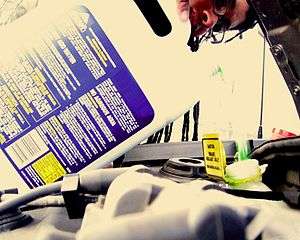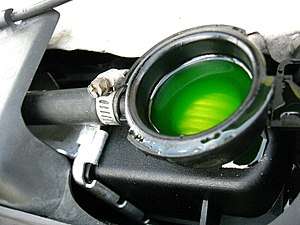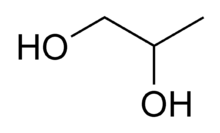Antifreeze
An antifreeze is an additive which lowers the freezing point of a water-based liquid. An antifreeze mixture is used to achieve freezing-point depression for cold environments. Common antifreezes increase the boiling point of the liquid, allowing higher coolant temperature.[1]

Because water has good properties as a coolant, water plus antifreeze is used in internal combustion engines and other heat transfer applications, such as HVAC chillers and solar water heaters. The purpose of antifreeze is to prevent a rigid enclosure from bursting due to expansion when water freezes. Commercially, both the additive (pure concentrate) and the mixture (diluted solution) are called antifreeze, depending on the context. Careful selection of an antifreeze can enable a wide temperature range in which the mixture remains in the liquid phase, which is critical to efficient heat transfer and the proper functioning of heat exchangers. Secondarily but not less importantly, most if not all commercial antifreeze formulations intended for use in heat transfer applications include different kinds of anti-corrosion and anti-cavitation agents that preserve the entire hydraulic circuit from progressive wear.
Principles and history
Water was the original coolant for internal combustion engines. It is cheap, nontoxic, and has a high heat capacity. It however has only a 100 °C liquid range, and it expands upon freezing. These problems are addressed by the development of alternative coolants with improved properties. Freezing and boiling points are colligative properties of a solution, which depend on the concentration of dissolved substances. Hence salts lower the melting points of aqueous solutions. Salts are frequently used for de-icing, but salt solutions are not used for cooling systems because they induce corrosion of metals. Low molecular weight organic compounds tend to have melting points lower than water, which recommends them as antifreeze agents. Solutions of organic compounds, especially alcohols, in water are effective. Alcohols - ethanol, methanol, ethylene glycol, etc. - have been the basis of all antifreezes since they were commercialized in the 1920s.[1]
Use and occurrence
Automotive and internal combustion engine use

Most automotive engines are "water"-cooled to remove waste heat, although the "water" is actually antifreeze/water mixture and not plain water. The term engine coolant is widely used in the automotive industry, which covers its primary function of convective heat transfer for internal combustion engines. When used in an automotive context, corrosion inhibitors are added to help protect vehicles' radiators, which often contain a range of electrochemically incompatible metals (aluminum, cast iron, copper, brass, solder, et cetera). Water pump seal lubricant is also added.
Antifreeze was developed to overcome the shortcomings of water as a heat transfer fluid.
On the other hand, if the engine coolant gets too hot, it might boil while inside the engine, causing voids (pockets of steam), leading to localized hot spots and the catastrophic failure of the engine. If plain water were to be used as an engine coolant, it would promote galvanic corrosion. Proper engine coolant and a pressurized coolant system obviate these shortcomings of water. With proper antifreeze, a wide temperature range can be tolerated by the engine coolant, such as −34 °F (−37 °C) to +265 °F (129 °C) for 50% (by volume) propylene glycol diluted with water and a 15 psi pressurized coolant system.[2][3]
Early engine coolant antifreeze was methanol (methyl alcohol). Ethylene glycol was developed because its higher boiling point was more compatible with heating systems.
Other industrial uses
The most common water-based antifreeze solutions used in electronics cooling are mixtures of water and either ethylene glycol (EGW) or propylene glycol (PGW). The use of ethylene glycol has a longer history, especially in the automotive industry. However, EGW solutions formulated for the automotive industry often have silicate based rust inhibitors that can coat and/or clog heat exchanger surfaces. Ethylene glycol is listed as a toxic chemical requiring care in handling and disposal.
Ethylene glycol has desirable thermal properties, including a high boiling point, low freezing point, stability over a wide range of temperatures, and high specific heat and thermal conductivity. It also has a low viscosity and, therefore, reduced pumping requirements. Although EGW has more desirable physical properties than PGW, the latter coolant is used in applications where toxicity might be a concern. PGW is generally recognized as safe for use in food or food processing applications, and can also be used in enclosed spaces.
Similar mixtures are commonly used in HVAC and industrial heating or cooling systems as a high-capacity heat transfer medium. Many formulations have corrosion inhibitors, and it is expected that these chemicals will be replenished (manually or under automatic control) to keep expensive piping and equipment from corroding.
Biological antifreezes
Antifreeze proteins refer to chemical compounds produced by certain animals, plants, and other organisms that prevent the formation of ice. In this way, these compounds allow their host organism to operate at temperatures well below the freezing point of water. Antifreeze proteins bind to small ice crystals to inhibit growth and recrystallization of ice that would otherwise be fatal.[4][5]
Primary agents
Ethylene glycol
Most antifreeze is made by mixing distilled water with additives and a base product – MEG (Mono ethylene glycol) or MPG (Mono propylene glycol). Ethylene glycol solutions became available in 1926 and were marketed as "permanent antifreeze" since the higher boiling points provided advantages for summertime use as well as during cold weather. They are used today for a variety of applications, including automobiles, but there are lower-toxicity alternatives made with propylene glycol available.
When ethylene glycol is used in a system, it may become oxidized to five organic acids (formic, oxalic, glycolic, glyoxalic and acetic acid). Inhibited ethylene glycol antifreeze mixes are available, with additives that buffer the pH and reserve alkalinity of the solution to prevent oxidation of ethylene glycol and formation of these acids. Nitrites, silicates, borates and azoles may also be used to prevent corrosive attack on metal.
Ethylene glycol has a bitter, sweet taste and causes inebriation. The toxic effects of ingesting ethylene glycol occur because it is converted by the liver into 4 other chemicals that are much more toxic. The lethal dose of pure ethylene glycol is 1.4 ml/kg (3 US fluid ounces (90 ml) is lethal to a 140-pound (64 kg) person) but is much less lethal if treated within an hour.[6] (see Ethylene glycol poisoning).
Propylene glycol

Propylene glycol is considerably less toxic than ethylene glycol and may be labeled as "non-toxic antifreeze". It is used as antifreeze where ethylene glycol would be inappropriate, such as in food-processing systems or in water pipes in homes where incidental ingestion may be possible. For example, the U.S. FDA allows propylene glycol to be added to a large number of processed foods, including ice cream, frozen custard, salad dressings, and baked goods, and it is commonly used as the main ingredient in the "e-liquid" used in electronic cigarettes.
Propylene glycol oxidizes to lactic acid.[7]
Besides cooling system corrosion, biological fouling also occurs. Once bacterial slime starts to grow, the corrosion rate of the system increases. Maintenance of systems using glycol solution includes regular monitoring of freeze protection, pH, specific gravity, inhibitor level, color, and biological contamination.
Propylene glycol should be replaced when it turns a reddish color. When an aqueous solution of propylene glycol in a cooling or heating system develops a reddish or black color, this indicates that iron in the system is corroding significantly. In the absence of inhibitors, propylene glycol can react with oxygen and metal ions, generating various compounds including organic acids (e.g., formic, oxalic, acetic). These acids accelerate the corrosion of metals in the system.[8][9][10][11]
Other antifreezes
Propylene glycol methyl ether is used as an antifreeze in diesel engines. It is more volatile than glycol.[1]
Once used for automotive antifreeze, glycerol has the advantage of being non-toxic, withstands relatively high temperatures, and is noncorrosive. It is not however used widely.[1] Glycerol was historically used as an antifreeze for automotive applications before being replaced by ethylene glycol.[12][13] Glycerol is mandated for use as an antifreeze in many sprinkler systems.
Measuring the freeze point
Once antifreeze has been mixed with water and put into use, it periodically needs to be maintained. If engine coolant leaks, boils, or if the cooling system needs to be drained and refilled, the antifreeze's freeze protection will need to be considered. In other cases a vehicle may need to be operated in a colder environment, requiring more antifreeze and less water. Three methods are commonly employed to determine the freeze point of the solution:[14]
- Specific gravity—(using a hydrometer test strip or some sort of floating indicator),
- Refractometer—which measures the refractive index of the antifreeze solution and translates it into freeze point, and
- Test strips—specialized, disposable indicators made for this purpose.
Although ethylene glycol hydrometers are widely available and mass-marketed for antifreeze testing, they give false readings at high temperatures because specific gravity changes with temperature.[14] Propylene glycol solutions cannot be tested using specific gravity because of ambiguous results (40% and 100% solutions have the same specific gravity).[14]
Corrosion inhibitors
Most commercial antifreeze formulations include corrosion inhibiting compounds, and a colored dye (commonly a fluorescent green, red, orange, yellow, or blue) to aid in identification.[15] A 1:1 dilution with water is usually used, resulting in a freezing point of about −34 °F (−37 °C), depending on the formulation. In warmer or colder areas, weaker or stronger dilutions are used, respectively, but a range of 40%/60% to 60%/40% is frequently specified to ensure corrosion protection, and 70%/30% for maximum freeze prevention down to −84 °F (−64 °C).[3]
Maintenance
In the absence of leaks, antifreeze chemicals such as ethylene glycol or propylene glycol may retain their basic properties indefinitely. By contrast, corrosion inhibitors are gradually used up, and must be replenished from time to time. Larger systems (such as HVAC systems) are often monitored by specialist firms which take responsibility for adding corrosion inhibitors and regulating coolant composition. For simplicity, most automotive manufacturers recommend periodic complete replacement of engine coolant, to simultaneously renew corrosion inhibitors and remove accumulated contaminants.
Traditional inhibitors
Traditionally, there were two major corrosion inhibitors used in vehicles: silicates and phosphates. American-made vehicles traditionally used both silicates and phosphates.[16] European makes contain silicates and other inhibitors, but no phosphates.[16] Japanese makes traditionally use phosphates and other inhibitors, but no silicates.[16][17]
Organic acid technology
Certain cars are built with organic acid technology (OAT) antifreeze (e.g., DEX-COOL[18]), or with a hybrid organic acid technology (HOAT) formulation (e.g., Zerex G-05),[19] both of which are claimed to have an extended service life of five years or 240,000 km (150,000 mi).
DEX-COOL specifically has caused controversy. Litigation has linked it with intake manifold gasket failures in General Motors' (GM's) 3.1L and 3.4L engines, and with other failures in 3.8L and 4.3L engines. One of the anti-corrosion components presented as sodium or potassium 2-ethylhexanoate and ethylhexanoic acid is incompatible with nylon 6,6 and silicone rubber, and is a known plasticizer. Class action lawsuits were registered in several states of the US, and in Canada,[20] to address some of these claims. The first of these to reach a decision was in Missouri, where a settlement was announced early in December 2007.[21] Late in March 2008, GM agreed to compensate complainants in the remaining 49 states.[22] GM (Motors Liquidation Company) filed for bankruptcy in 2009, which tied up the outstanding claims until a court determines who gets paid.[23]
According to the DEX-COOL manufacturer, "mixing a 'green' [non-OAT] coolant with DEX-COOL reduces the batch's change interval to 2 years or 30,000 miles, but will otherwise cause no damage to the engine".[24] DEX-COOL antifreeze uses two inhibitors: sebacate and 2-EHA (2-ethylhexanoic acid), the latter which works well with the hard water found in the United States, but is a plasticizer that can cause gaskets to leak.[16]
According to internal GM documents[24], the ultimate culprit appears to be operating vehicles for long periods of time with low coolant levels. The low coolant is caused by pressure caps that fail in the open position. (The new caps and recovery bottles were introduced at the same time as DEX-COOL). This exposes hot engine components to air and vapors, causing corrosion and contamination of the coolant with iron oxide particles, which in turn can aggravate the pressure cap problem as contamination holds the caps open permanently.[24]
Honda and Toyota's new extended life coolant use OAT with sebacate, but without the 2-EHA. Some added phosphates provide protection while the OAT builds up.[16] Honda specifically excludes 2-EHA from their formulas.
Typically, OAT antifreeze contains an orange dye to differentiate it from the conventional glycol-based coolants (green or yellow), though some OAT products may contain a red or mauve dye. Some of the newer OAT coolants claim to be compatible with all types of OAT and glycol-based coolants; these are typically green or yellow in color.[15]
Hybrid organic acid technology
HOAT coolants typically mix an OAT with a traditional inhibitor, usually silicates. [25]
An example is Zerex G05, which is a low-silicate, phosphate free formula that includes the benzoate inhibitor.[16]
A HOAT coolant can have a life expectancy as high as 10 years / 180,000 miles.[25]
Additives
All automotive antifreeze formulations, including the newer organic acid (OAT antifreeze) formulations, are environmentally hazardous because of the blend of additives (around 5%), including lubricants, buffers and corrosion inhibitors.[26] Because the additives in antifreeze are proprietary, the safety data sheets (SDS) provided by the manufacturer list only those compounds which are considered to be significant safety hazards when used in accordance with the manufacturer's recommendations. Common additives include sodium silicate, disodium phosphate, sodium molybdate, sodium borate, denatonium benzoate and dextrin (hydroxyethyl starch).
Disodium fluorescein dye is added to conventional ethylene glycol formulas to visually distinguish leaked amounts from other vehicle fluids, and as a marker of type to distinguish it from incompatible types.[15] This dye fluoresces bright green when illuminated by blue or UV light from daylight or testing lamps.
Automotive antifreeze has a characteristic odor due to the additive tolytriazole, a corrosion inhibitor. The unpleasant odor in industrial use tolytriazole comes from impurities in the product that are formed from the toluidine isomers (ortho-, meta- and para-toluidine) and meta-diamino toluene which are side-products in the manufacture of tolytriazole.[27] These side-products are highly reactive and produce volatile aromatic amines which are responsible for the unpleasant odor.[28]
See also
References
- Bosen, Sidney F.; Bowles, William A.; Ford, Emory A.; Perlson, Bruce D. (2000). "Antifreezes". Ullmann's Encyclopedia of Industrial Chemistry. Weinheim: Wiley-VCH. doi:10.1002/14356007.a03_023.
- Prestone Press Release
- Peak Antifreeze chart Archived October 5, 2010, at the Wayback Machine
- Goodsell D (December 2009). "Molecule of the Month: Antifreeze Proteins". The Scripps Research Institute and the RCSB PDB. doi:10.2210/rcsb_pdb/mom_2009_12.
- Fletcher GL, Hew CL, Davies PL (2001). "Antifreeze proteins of teleost fishes". Annual Review of Physiology. 63: 359–90. doi:10.1146/annurev.physiol.63.1.359. PMID 11181960.
- PM Leth, M Gregersen. Ethylene glycol poisoning. Forensic science international, 2005 - Elsevier
- Evaluation of Certain Food Additives and Contaminants (Technical Report Series). World Health Organization. p. 105. ISBN 92-4-120909-7.
- Hartwick, D.; Hutchinson, D.; Langevin, M., "A multi-discipline approach to closed system treatment," Corrosion 2004; New Orleans, Louisiana; March 28 - April 1, 2004; NACE (National Association of Corrosion Engineers) paper 04-322. See: Document preview.
- Kenneth Soeder, Daniel Benson, and Dennis Tomsheck, "An on-line cleaning procedure used to remove iron and microbiological fouling from a critical glycol-contaminated closed-loop cooling water system," 2007 Annual Convention and Exposition of the Association of Water Technologies; Colorado Springs, Colorado; November 7–10, 2007
- Allan Browning and David Berry (September / October 2010) "Selecting and maintaining glycol based heat transfer fluids," Facilities Engineering Journal, pages 16-18.
- Walter J. Rossiter, Jr., McClure Godette, Paul W. Brown and Kevin G. Galuk (1985) "An investigation of the degradation of aqueous ethylene glycol and propylene glycol solutions using ion chromatography," Solar Energy Materials, vol. 11, pages 455-467.
- Hudgens, R. Douglas; Hercamp, Richard D.; Francis, Jaime; Nyman, Dan A.; Bartoli, Yolanda (2007). "An Evaluation of Glycerin (Glycerol) as a Heavy Duty Engine Antifreeze/Coolant Base". doi:10.4271/2007-01-4000. Retrieved 2013-06-07. Cite journal requires
|journal=(help) - "Proposed ASTM Engine Coolant Standards Focus on Glycerin". Retrieved 2013-06-07.
- Engine Cooling Testing: Why use a refractometer? Archived July 25, 2011, at the Wayback Machine posted 2/7/2001 by Michael Reimer
- Coolants Matrix 2003_5.xls. (PDF) . Retrieved on 2011-01-01. Archived 2008-04-16 at the Wayback Machine
- "Coolant Confusion: It's Not Easy Being Green ... or Yellow or Orange or ..." motor.com. Retrieved 2013-06-07.
- "Coolant Confusion". Archived from the original on 2013-05-12. Retrieved 2013-06-07.
- Products: North America: Anti Freeze/Coolants. Havoline.com (2003-01-31). Retrieved on 2011-01-01.
- "Zerex G-05® Antifreeze / Coolant". Retrieved 2013-06-07.
- "Canadian Nationwide Class Action Settlement Agreement" (PDF). Archived from the original (pdf) on 2013-05-12. Retrieved 2013-06-07.
- Tentative Settlement of GM DEX-COOL Class Action Suit
- DEX-COOL Litigation Website
- "GM wants to dump liability for damaged engines in Dex-Cool cases". Retrieved 2013-06-07.
- Draft—DEX 2007, Part 3: Now It’s All Up To The Judges and Juries. Imcool.com. Retrieved on 2011-01-01.
- A safe and effective propylene glycol based capture liquid for fruit fly traps baited with synthetic lures – page 2|Florida Entomologist. Findarticles.com. Retrieved on 2011-01-01.
- VOGT, P. F. 2005. Tolytriazole-myth and misconceptions. The Analyst 12: 1–3.
- A safe and effective propylene glycol based capture liquid for fruit fly traps baited with synthetic lures; Florida Entomologist, June, 2008 by Donald B. Thomas